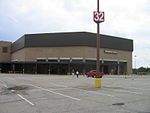James Russell Lowell Elementary School (Louisville, Kentucky)
1916 establishments in Kentucky1993 disestablishments in KentuckyArt Deco architecture in KentuckyBuildings and structures demolished in 1993Defunct schools in Louisville, Kentucky ... and 8 more
Demolished buildings and structures in Louisville, KentuckyDemolished but still listed on the National Register of Historic PlacesKentucky school stubsLouisville, Kentucky building and structure stubsNational Register of Historic Places in Louisville, KentuckyPublic elementary schools in KentuckySchool buildings completed in 1916School buildings on the National Register of Historic Places in Kentucky

James Russell Lowell Elementary School was located at 4501 Crittenden Drive in the Highland Park neighborhood of Louisville, Kentucky. Construction began in 1916 on the original portion of the building that was known as Highland Park School and had the only remaining bell tower on a Public School in Louisville, Kentucky. Subsequent construction began in 1931 and the school became known as Lowell. The school was later demolished in 1993. The school was listed on the National Register of Historic Places listings in Jefferson County, Kentucky on September 6, 1983.
Excerpt from the Wikipedia article James Russell Lowell Elementary School (Louisville, Kentucky) (License: CC BY-SA 3.0, Authors, Images).James Russell Lowell Elementary School (Louisville, Kentucky)
Crittenden Drive, Louisville
Geographical coordinates (GPS) Address Nearby Places Show on map
Geographical coordinates (GPS)
| Latitude | Longitude |
|---|---|
| N 38.188 ° | E -85.751 ° |
Address
Crittenden Drive 4598
40221 Louisville
Kentucky, United States
Open on Google Maps








